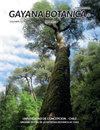Bryophyte diversity as an indication of habitat quality in two special areas of conservation on the outskirts of Vilnius (Verkiai Regional Park)
IF 0.5
4区 生物学
Q4 PLANT SCIENCES
引用次数: 1
Abstract
The research results on bryophyte diversity in two special areas of conservation (Environs of Lakes Žalieji and Ežerėliai Complex ) included into the Natura 2000 network and occurring on the outskirts of Vilnius are presented. The study aimed to ascertain bryophyte diversity at the studied sites. In addition, the conservation status of habitats protected under the European Union Habitats Directive in terms of bryophyte species they contain was evaluated. The research was carried out in 2019–2020 and 2022 and covered all habitat types and substrata in the territories. A total of 110 bryophyte species (11 liverworts and 99 mosses) were recorded in both studied areas. About 70% of bryophytes were recorded in one of the areas. Among 13 habitats protected under the Habitats Directive, bryophyte diversity in three of them confirmed their favourable status. Habitats with dominant deciduous trees (9020 Fennoscandian hemiboreal natural old broad-leaved deciduous forests rich in epiphytes and 9180 Tilio-Acerion forests of slopes, screes and ravines) distributed in the area Environs of Lakes Žalieji were characterised by a large number of epiphytes, among which there were also indicators of favourable habitat conservation status. In both habitats, Dicranum viride was recorded. Our research did not reveal bryophyte species indicating the favourable status of 9010 Western taiga habitats. In contrast, small areas of wetland habitats are of favourable conservation status. Three typical bryophyte species (Hamatocaulis vernicosus, Sphagnum warnstorfii and Tomentypnum nitens) were recorded in 7140 Transition mires and quaking bogs (the area Ežerėliai Complex). The results of our study confirm that some habitats of Vilnius outskirts, despite increased pressure of urbanisation, are still able to maintain favourable status.维尔纽斯郊区两个特殊保护区苔藓植物多样性作为生境质量指标(Verkiai地区公园)
本文介绍了维尔纽斯郊区的两个特殊保护区(湖周围Žalieji和Ežerėliai Complex)的苔藓植物多样性的研究结果。本研究旨在确定研究地点苔藓植物的多样性。此外,还对欧盟生境指令保护的生境的苔藓植物种类进行了评价。该研究于2019-2020年和2022年进行,涵盖了该领土的所有栖息地类型和基质。研究区共记录苔藓植物110种,其中苔类植物11种,苔藓类植物99种。其中一个地区记录的苔藓植物约占70%。在《生境指令》保护的13个生境中,有3个生境的苔藓植物多样性处于有利地位。在该地区分布有优势落叶乔木的生境(9020个芬诺斯坎德半北方自然老阔叶落叶林,其中有丰富的附生植物和9180个斜坡、梯地和沟谷的tilo - acerion林),其中有大量的附生植物,其中也有生境保护状况良好的指标。在这两个生境中,都记录到了翠绿狄克兰。本研究未发现9010西部针叶林生境有利的苔藓植物种类。而小面积湿地生境则具有良好的保护状况。7140个过渡沼泽和地震沼泽(Ežerėliai复区)记录了3种典型苔藓植物(Hamatocaulis vernicosus、Sphagnum warnstorfii和Tomentypnum nitens)。我们的研究结果证实,维尔纽斯郊区的一些栖息地,尽管城市化的压力增加,仍然能够保持有利的地位。
本文章由计算机程序翻译,如有差异,请以英文原文为准。
求助全文
约1分钟内获得全文
求助全文
来源期刊

GAYANA BOTANICA
Agricultural and Biological Sciences-Plant Science
CiteScore
0.70
自引率
0.00%
发文量
8
审稿时长
6-12 weeks
期刊介绍:
The journal welcomes works carried out by scientists of all nationalities, and may be written in either English or Spanish. The journal receives works in systematic, taxonomy, floristic, ecology, physiology, morphology, development, conservation, cytology and phytochemical botany.
 求助内容:
求助内容: 应助结果提醒方式:
应助结果提醒方式:


